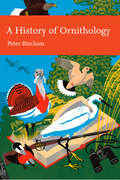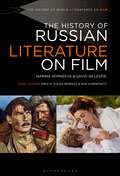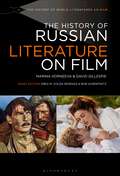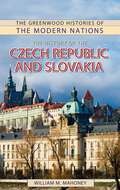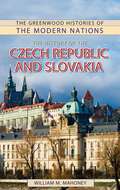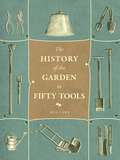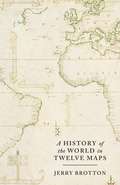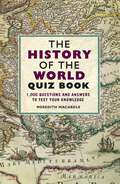- Table View
- List View
A History of Ornithology (Collins New Naturalist Library #104)
by Peter BirchamWhat did we know about birds a thousand years ago, and how has our understanding developed? ‘A History of Ornithology’ offers a complete history of birdwatching in Britain, a classic for every nature lover's bookshelf.
History of Programming Languages
by Richard L. WexelblatHistory of Programming Languages presents information pertinent to the technical aspects of the language design and creation. This book provides an understanding of the processes of language design as related to the environment in which languages are developed and the knowledge base available to the originators.Organized into 14 sections encompassing 77 chapters, this book begins with an overview of the programming techniques to use to help the system produce efficient programs. This text then discusses how to use parentheses to help the system identify identical subexpressions within an expression and thereby eliminate their duplicate calculation. Other chapters consider FORTRAN programming techniques needed to produce optimum object programs. This book discusses as well the developments leading to ALGOL 60. The final chapter presents the biography of Adin D. Falkoff.This book is a valuable resource for graduate students, practitioners, historians, statisticians, mathematicians, programmers, as well as computer scientists and specialists.
The History of Russian Literature on Film (The History of World Literatures on Film)
by Marina Korneeva David GillespieUnlike most previous studies of literature and film, which tend to privilege particular authors, texts, or literary periods, David Gillespie and Marina Korneeva consider the multiple functions of filmed Russian literature as a cinematic subject in its own right-one reflecting the specific political and aesthetic priorities of different national and historical cinemas. In this first and only comprehensive study of cinema's various engagements of Russian literature focusing on the large period 1895-2015, The History of Russian Literature on Film highlights the ways these adaptations emerged from and continue to shape the social, artistic, and commercial aspects of film history.
The History of Russian Literature on Film (The History of World Literatures on Film)
by Marina Korneeva David GillespieUnlike most previous studies of literature and film, which tend to privilege particular authors, texts, or literary periods, David Gillespie and Marina Korneeva consider the multiple functions of filmed Russian literature as a cinematic subject in its own right-one reflecting the specific political and aesthetic priorities of different national and historical cinemas. In this first and only comprehensive study of cinema's various engagements of Russian literature focusing on the large period 1895-2015, The History of Russian Literature on Film highlights the ways these adaptations emerged from and continue to shape the social, artistic, and commercial aspects of film history.
History of Social Law in Germany
by Michael StolleisThe sole available comprehensive history of social law and the model of social welfare in Germany. The book explains the origins since the medieval times, but concentrates on the 19th and 20th centuries, especially on the introduction of the social insurance 1881-1889, of the expansion of the system in the Weimar Republic, under the Nazi-System and after World War II in the FRG and the GDR. The system of social welfare in Germany is one of the pillars of economic stability.
The History of Suffrage, 1760-1867 Vol 3
by Anna Clark Sarah RichardsonThis work brings together key texts drawn from the history of suffrage advocacy and agitation. The whole issue of voting rights and representation is shown to be anchored firmly in the wider political culture of Britain and Ireland as well as the Empire as a whole. Volume 3 covers texts from 1731 to 1832.
The History of Suffrage, 1760-1867 Vol 3
by Anna Clark Sarah RichardsonThis work brings together key texts drawn from the history of suffrage advocacy and agitation. The whole issue of voting rights and representation is shown to be anchored firmly in the wider political culture of Britain and Ireland as well as the Empire as a whole. Volume 3 covers texts from 1731 to 1832.
The History of Suffrage, 1760-1867 Vol 4
by Anna Clark Sarah RichardsonThis work brings together key texts drawn from the history of suffrage advocacy and agitation. The whole issue of voting rights and representation is shown to be anchored firmly in the wider political culture of Britain and Ireland as well as the Empire as a whole. Volume 4 covers texts from 1839 to 1859.
The History of Suffrage, 1760-1867 Vol 4
by Anna Clark Sarah RichardsonThis work brings together key texts drawn from the history of suffrage advocacy and agitation. The whole issue of voting rights and representation is shown to be anchored firmly in the wider political culture of Britain and Ireland as well as the Empire as a whole. Volume 4 covers texts from 1839 to 1859.
History of Technology Volume 27 (History of Technology)
by Ian InksterThe technical problems confronting different societies and periods and the measures taken to solve them form the concern of this annual collection of essays. It deals with the history of technical discovery and change and explores the relationship of technology to other aspects of life - social, cultural and economic - and shows how technological development has shaped, and been shaped by, the society in which it occurred. Volume 27 includes a special issue on The Professional Identity of Engineers:Historical and Contemporary Issues.
History of Technology Volume 27 (History of Technology #Volume 27)
by Ian InksterThe technical problems confronting different societies and periods and the measures taken to solve them form the concern of this annual collection of essays. It deals with the history of technical discovery and change and explores the relationship of technology to other aspects of life - social, cultural and economic - and shows how technological development has shaped, and been shaped by, the society in which it occurred. Volume 27 includes a special issue on The Professional Identity of Engineers:Historical and Contemporary Issues.
A History of the Application of Islamic Law in Nigeria
by Yushau SodiqThis work analyzes the history of the application of Islamic law (Shari`ah) in Nigeria. It analyzes how Islamic law emerged in Nigeria toward the beginning of the 19th century and remained applicable until the arrival of the British Colonial regime in Northern Nigeria in 1903. It sheds light on how the law survived colonial rule and continues until today. Dr. Yushau Sodiq analyzes progressive elements in Islamic law over the past two centuries. He goes on to discuss many objections raised by the Nigerian Christians against the application of Islamic law, as well as how Muslims respond to such criticism. In a world that is often saturated with Islamophobia and ignorant misconceptions about Islam, this book aims to clarify and respond to many important concepts and ideas within Islamic religious tradition.
A History of the Application of Islamic Law in Nigeria
by Yushau SodiqThis work analyzes the history of the application of Islamic law (Shari`ah) in Nigeria. It analyzes how Islamic law emerged in Nigeria toward the beginning of the 19th century and remained applicable until the arrival of the British Colonial regime in Northern Nigeria in 1903. It sheds light on how the law survived colonial rule and continues until today. Dr. Yushau Sodiq analyzes progressive elements in Islamic law over the past two centuries. He goes on to discuss many objections raised by the Nigerian Christians against the application of Islamic law, as well as how Muslims respond to such criticism. In a world that is often saturated with Islamophobia and ignorant misconceptions about Islam, this book aims to clarify and respond to many important concepts and ideas within Islamic religious tradition.
The History of the Contractual Thoughts in Ancient China
by Yunsheng LiuThis book explores the intellectual history of contract law in ancient China by employing archaeological and empirical methodologies. Divided into five chapters, it begins by reviewing the origin of the contract in ancient China, and analyzing its name, primary form, historical premise and functions. The second chapter discusses free will and lawfulness in the establishment of a contract, offering insights into the impact of contracts on social justice. In turn, the third chapter addresses the inner core of the contract: validity and liability. This allows readers at all levels to identify the similarities and differences between contracts from different eras and different parts of the world, which will also benefit those pursuing comparative research in related fields. Chapters four and five offer a philosophical exploration of contract history in ancient China, and analyze key aspects including human nature and ethical justice.
The History of the Czech Republic and Slovakia (The Greenwood Histories of the Modern Nations)
by William MahoneyThis survey of Czech and Slovak history traces the development of two neighboring peoples through the creation of a common Czechoslovakian state in 1918 to the founding of the independent Czech and Slovak Republics in 1993 and beyond.The History of the Czech Republic and Slovakia charts historical developments in the two nations to the opening decade of the 21st century. The book begins with an overview of the geography, climate, people, economy, and government of both the Czech and Slovak republics. Subsequent chapters offer a chronologically organized survey of historical events, trends, ideas, and people.Starting with the early Slavic settlements around the 5th century AD, the book explores Czech and Slovak history through the Middle Ages, the Renaissance and Early Modern eras, the Enlightenment, and the age of nationalism and revolution. Chapters on the 20th century include discussion of the World Wars, the interwar Czechoslovak state, the Communist decades, the Prague Spring, and the Velvet Revolution of 1989. The story is brought up to date with insights into developments in the independent Czech and Slovak republics since 1993.
The History of the Czech Republic and Slovakia (The Greenwood Histories of the Modern Nations)
by William MahoneyThis survey of Czech and Slovak history traces the development of two neighboring peoples through the creation of a common Czechoslovakian state in 1918 to the founding of the independent Czech and Slovak Republics in 1993 and beyond.The History of the Czech Republic and Slovakia charts historical developments in the two nations to the opening decade of the 21st century. The book begins with an overview of the geography, climate, people, economy, and government of both the Czech and Slovak republics. Subsequent chapters offer a chronologically organized survey of historical events, trends, ideas, and people.Starting with the early Slavic settlements around the 5th century AD, the book explores Czech and Slovak history through the Middle Ages, the Renaissance and Early Modern eras, the Enlightenment, and the age of nationalism and revolution. Chapters on the 20th century include discussion of the World Wars, the interwar Czechoslovak state, the Communist decades, the Prague Spring, and the Velvet Revolution of 1989. The story is brought up to date with insights into developments in the independent Czech and Slovak republics since 1993.
A History of the Garden in Fifty Tools
by Bill LawsA green thumb is not the only tool one needs to garden well—at least that’s what the makers of gardening catalogs and the designers of the dizzying aisle displays in lawn- and-garden stores would have us believe. Need to plant a bulb, aerate some soil, or keep out a hungry critter? Well, there’s a specific tool for almost everything. But this isn’t just a product of today’s consumer era, since the very earliest gardens, people have been developing tools to make planting and harvesting more efficient and to make flora more beautiful and trees more fruitful. In A History of the Garden in Fifty Tools, Bill Laws offers entertaining and colorful anecdotes of implements that have shaped our gardening experience since the beginning. As Laws reveals, gardening tools have coevolved with human society, and the story of these fifty individual tools presents an innovative history of humans and the garden over time. Laws takes us back to the Neolithic age, when the microlith, the first “all-in-one” tool was invented. Consisting of a small sharp stone blade that was set into a handle made of wood, bone, or antler, it was a small spade that could be used to dig, clip, and cut plant material. We find out that wheelbarrows originated in China in the second century BC, and their basic form has not changed much since. He also describes how early images of a pruning knife appear in Roman art, in the form of a scythe that could cut through herbs, vegetables, fruits, and nuts and was believed to be able to tell the gardener when and what to harvest. Organized into five thematic chapters relating to different types of gardens: the flower garden, the kitchen garden, the orchard, the lawn, and ornamental gardens, the book includes a mix of horticulture and history, in addition to stories featuring well-known characters—we learn about Henry David Thoreau’s favorite hoe, for example. A History of the Garden in Fifty Tools will be a beautiful gift for any home gardener and a reassuring reminder that gardeners have always struggled with the same quandaries.
A History of the Garden in Fifty Tools
by Bill LawsA green thumb is not the only tool one needs to garden well—at least that’s what the makers of gardening catalogs and the designers of the dizzying aisle displays in lawn- and-garden stores would have us believe. Need to plant a bulb, aerate some soil, or keep out a hungry critter? Well, there’s a specific tool for almost everything. But this isn’t just a product of today’s consumer era, since the very earliest gardens, people have been developing tools to make planting and harvesting more efficient and to make flora more beautiful and trees more fruitful. In A History of the Garden in Fifty Tools, Bill Laws offers entertaining and colorful anecdotes of implements that have shaped our gardening experience since the beginning. As Laws reveals, gardening tools have coevolved with human society, and the story of these fifty individual tools presents an innovative history of humans and the garden over time. Laws takes us back to the Neolithic age, when the microlith, the first “all-in-one” tool was invented. Consisting of a small sharp stone blade that was set into a handle made of wood, bone, or antler, it was a small spade that could be used to dig, clip, and cut plant material. We find out that wheelbarrows originated in China in the second century BC, and their basic form has not changed much since. He also describes how early images of a pruning knife appear in Roman art, in the form of a scythe that could cut through herbs, vegetables, fruits, and nuts and was believed to be able to tell the gardener when and what to harvest. Organized into five thematic chapters relating to different types of gardens: the flower garden, the kitchen garden, the orchard, the lawn, and ornamental gardens, the book includes a mix of horticulture and history, in addition to stories featuring well-known characters—we learn about Henry David Thoreau’s favorite hoe, for example. A History of the Garden in Fifty Tools will be a beautiful gift for any home gardener and a reassuring reminder that gardeners have always struggled with the same quandaries.
A History of the U.S. Political System [3 volumes]: Ideas, Interests, and Institutions [3 volumes]
This reference resource combines unique historical analysis, scholarly essays, and primary source documents to explore the evolution of ideas and institutions that have shaped American government and Americans' political behavior.One of the most active and revealing approaches to research into the American political system is one that focuses on political development, an approach that combines the tools of the political scientist and the historian. A History of the U.S. Political System: Ideas, Interests, and Institutions is the first comprehensive resource that uses this approach to explore the evolution of the American political system from the adoption of the Constitution to the present.A History of the U.S. Political System is a three-volume collection of original essays and primary documents that examines the ideas, institutions, and policies that have shaped American government and politics throughout its history. The first volume is issues-oriented, covering governmental and nongovernmental institutions as well as key policy areas. The second volume examines America's political development historically, surveying its dynamic government era by era. Volume three is a collection of documentary materials that supplement and enhance the reader's experience with the other volumes.
A History of the World in 100 Weapons (General Military Ser.)
by Chris McNabOur history has been shaped and changed by weapons: the smallest advances in weapons development have helped to build and overthrow empires, changed the course of civilization, driven modern technology, and won wars. For thousands of years, individual pieces of weaponry have come to symbolize struggles and nations, from the Roman gladius to the English longbow, and from the flintlock musket through to the AK47. This book reveals the weapons that had the greatest impact on our history, explaining how and why they came to prominence, and uncovers the lasting effect they had on the world.
A History of the World in 100 Weapons
by Chris McNabOur history has been shaped and changed by weapons: the smallest advances in weapons development have helped to build and overthrow empires, changed the course of civilization, driven modern technology, and won wars. For thousands of years, individual pieces of weaponry have come to symbolize struggles and nations, from the Roman gladius to the English longbow, and from the flintlock musket through to the AK47. This book reveals the weapons that had the greatest impact on our history, explaining how and why they came to prominence, and uncovers the lasting effect they had on the world.
The History of the World in Bite-Sized Chunks
by Emma MarriottHistory is a rich, varied and fascinating subject, so it's rare to find the whole lot in one book ... until now. The History of the World in Bite-Sized Chunks pulls it all together, from the world's earliest civilizations in 3500 BC to the founding of the United Nations in 1945, passing by the likes of Charlemagne, the Ottoman Empire and the Crimean War, to name a few. Here's your chance to introduce yourself to the full spectrum of world history, and discover just how the modern world came to be.
A History of the World in Numbers
by Emma MarriottThe history of our world can be told through numbers. Numbers can illuminate the broad sweep of history, from vast movements of populations and the expansion of empires to the effects of technological achievements or climatic change. They also allow us to drill into the real detail of history, from the page count, the cost and the time it took to produce the Gutenberg Bible (the West's first mass-produced book) to the price of Virginian tobacco in the 1620s, both of which had an immediate and lasting effect on the course of world history.And, just occasionally, numbers have the power to blow our minds. For example: in 2003 US research showed that one in every 200 men living on the planet today shares genetic material from a single male from around 900 years ago; the likely progenitor was Mongol emperor, Genghis Khan.A History of the World in Numbers will span the early civilizations of man, from the plains of Mesopotamia and the Indus Empire, right through to the modern day. The numbers, statistics and figures will dictate the topic of each entry, shining a light on each subject, whether it's the development of early writing in China or the number of Brodie helmets issued in World War One.
A History of the World in Twelve Maps
by Jerry BrottonJerry Brotton is the presenter of the acclaimed BBC4 series 'Maps: Power, Plunder and Possession'. Here he tells the story of our world through maps.Throughout history, maps have been fundamental in shaping our view of the world, and our place in it. But far from being purely scientific objects, world maps are unavoidably ideological and subjective, intimately bound up with the systems of power and authority of particular times and places. Mapmakers do not simply represent the world, they construct it out of the ideas of their age.In this scintillating book, Jerry Brotton examines the significance of 12 maps - from the mystical representations of ancient history to the satellite-derived imagery of today. He vividly recreates the environments and circumstances in which each of the maps was made, showing how each conveys a highly individual view of the world - whether the Jerusalem-centred Christian perspective of the 14th century Hereford Mappa Mundi or the Peters projection of the 1970s which aimed to give due weight to 'the third world'.Although the way we map our surroundings is once more changing dramatically, Brotton argues that maps today are no more definitive or objective than they have ever been - but that they continue to make arguments and propositions about the world, and to recreate, shape and mediate our view of it. Readers of this book will never look at a map in quite the same way again.
The History of the World Quiz Book: 1,000 Questions and Answers to Test Your Knowledge
by Meredith MacArdleTaking the history of the world as its basis might seem a mammoth task but this fascinating book does just that, breaking the whole lot down into ten enthralling chapters that cover the ages and the world, from the Bronze Age up until the end of the Second World War.With over 5,500 years to choose from, and a whole world of events, you can be sure there is no shortage of intriguing history to explore. From the first empires and civilizations, through the Ancient world of the Middle East and Africa; the Parthian Empire; the Golden Age of India; the ancient dynasties of China; the founding of Rome and the Roman republic; Peruvian cultures; The Middle Ages; the Byzantine Empire; Mayan culture; the Crusades; the rise of the Ottoman Empire; the Renaissance – this far-reaching book will test the knowledge of any history lover and provide the ultimate challenge for even the most knowledgeable historian.With questions ranging through multiple choice, truth or fiction, maps and pictures, you will find there is always something new to learn about the world.
